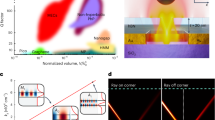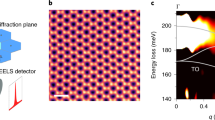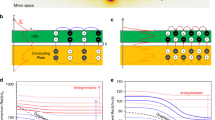Abstract
Light confinement in nanostructures produces an enhanced light–matter interaction that enables a vast range of applications including single-photon sources, nanolasers and nanosensors. In particular, nanocavity-confined polaritons display a strongly enhanced light–matter interaction in the infrared regime. This interaction could be further boosted if polaritonic modes were moulded to form whispering-gallery modes; but scattering losses within nanocavities have so far prevented their observation. Here, we show that hexagonal BN nanotubes act as an atomically smooth nanocavity that can sustain phonon-polariton whispering-gallery modes, owing to their intrinsic hyperbolic dispersion and low scattering losses. Hyperbolic whispering-gallery phonon polaritons on BN nanotubes of ~4 nm radius (sidewall of six atomic layers) are characterized by an ultrasmall nanocavity mode volume (Vm ≈ 10–10λ03 at an optical wavelength λ0 ≈ 6.4 μm) and a Purcell factor (Q/Vm) as high as 1012. We posit that BN nanotubes could become an important material platform for the realization of one-dimensional, ultrastrong light–matter interactions, with exciting implications for compact photonic devices.
This is a preview of subscription content, access via your institution
Access options
Access Nature and 54 other Nature Portfolio journals
Get Nature+, our best-value online-access subscription
$29.99 / 30 days
cancel any time
Subscribe to this journal
Receive 12 print issues and online access
$259.00 per year
only $21.58 per issue
Buy this article
- Purchase on Springer Link
- Instant access to full article PDF
Prices may be subject to local taxes which are calculated during checkout




Similar content being viewed by others
Data availability
The data that support the findings of this study are available within the paper and the Supplementary Information. Other relevant data are available from the corresponding authors upon reasonable request. Source data are provided with this paper.
Code availability
The codes that support the findings of this study are available from the corresponding authors upon reasonable request.
References
Oulton, R. F. et al. Plasmon lasers at deep subwavelength scale. Nature 461, 629–632 (2009).
Wang, Y. et al. Stable, high-performance sodium-based plasmonic devices in the near infrared. Nature 581, 401–405 (2020).
Rodrigo, D. et al. Mid-infrared plasmonic biosensing with graphene. Science 349, 165–168 (2015).
Stockman, M. I. Nanoplasmonic sensing and detection. Science 348, 287–288 (2015).
Tittl, A. et al. Imaging-based molecular barcoding with pixelated dielectric metasurfaces. Science 360, 1105–1109 (2018).
Sivis, M. et al. Tailored semiconductors for high-harmonic optoelectronics. Science 357, 303–306 (2017).
Zasedatelev, A. V. et al. Single-photon nonlinearity at room temperature. Nature 597, 493–497 (2021).
Yoo, D. et al. Ultrastrong plasmon–phonon coupling via epsilon-near-zero nanocavities. Nat. Photon. 15, 125–130 (2021).
Mirhosseini, M. et al. Cavity quantum electrodynamics with atom-like mirrors. Nature 569, 692–697 (2019).
Wang, K. et al. Coherent interaction between free electrons and a photonic cavity. Nature 582, 50–54 (2020).
Rivera, N. & Kaminer, I. Light–matter interactions with photonic quasiparticles. Nat. Rev. Phys. 2, 538–561 (2020).
Forn-Díaz, P., Lamata, L., Rico, E., Kono, J. & Solano, E. Ultrastrong coupling regimes of light-matter interaction. Rev. Mod. Phys. 91, 025005 (2019).
Kfir, O. et al. Controlling free electrons with optical whispering-gallery modes. Nature 582, 46–49 (2020).
Agio, M. & Cano, D. M. The Purcell factor of nanoresonators. Nat. Photon. 7, 674–675 (2013).
Min, B. et al. High-Q surface-plasmon-polariton whispering-gallery microcavity. Nature 457, 455–458 (2009).
Yao, J., Yang, X., Yin, X., Bartal, G. & Zhang, X. Three-dimensional nanometer-scale optical cavities of indefinite medium. Proc. Natl Acad. Sci. USA 108, 11327–11331 (2011).
Su, Y., Chang, P., Lin, C. & Helmy, A. Record Purcell factors in ultracompact hybrid plasmonic ring resonators. Sci. Adv. 5, eaav1790 (2019).
Alcaraz Iranzo, D. et al. Probing the ultimate plasmon confinement limits with a van der Waals heterostructure. Science 360, 291–295 (2018).
Epstein, I. et al. Far-field excitation of single graphene plasmon cavities with ultracompressed mode volumes. Science 368, 1219–1223 (2020).
Alfaro-Mozaz, F. J. et al. Deeply subwavelength phonon-polaritonic crystal made of a van der Waals material. Nat. Commun. 10, 42 (2019).
Long, J. C. et al. Upper limits to submillimetre-range forces from extra space-time dimensions. Nature 421, 922–925 (2003).
Vahala, K. J. Optical microcavities. Nature 424, 839–846 (2003).
Jiang, N., Zhuo, X. & Wang, J. Active plasmonics: principles, structures, and applications. Chem. Rev. 118, 3054–3099 (2018).
Lee, I.-H., Yoo, D., Avouris, P., Low, T. & Oh, S.-H. Graphene acoustic plasmon resonator for ultrasensitive infrared spectroscopy. Nat. Nanotechnol. 14, 313–319 (2019).
Cho, C. H. et al. Tailoring hot-exciton emission and lifetimes in semiconducting nanowires via whispering-gallery nanocavity plasmons. Nat. Mater. 10, 669–675 (2011).
Cho, C. H., Aspetti, C. O., Park, J. & Agarwal, R. Silicon coupled with plasmon nanocavity generates bright visible hot-luminescence. Nat. Photon. 7, 285–289 (2013).
Yan, H. et al. Damping pathways of mid-infrared plasmons in graphene nanostructures. Nat. Photon. 7, 394–399 (2013).
Lee, I. H. et al. Image polaritons in boron nitride for extreme polariton confinement with low losses. Nat. Commun. 11, 3649 (2020).
Lundeberg, M. B. et al. Tuning quantum nonlocal effects in graphene plasmonics. Science 357, 187–191 (2017).
Dai, S. et al. Tunable phonon polaritons in atomically thin van der Waals crystals of boron nitride. Science 343, 1125–1129 (2014).
Giles, A. J. et al. Ultralow-loss polaritons in isotopically pure boron nitride. Nat. Mater. 17, 134–139 (2018).
Basov, D. N., Fogler, M. M. & Garcia de Abajo, F. J. Polaritons in van der Waals materials. Science 354, aag1992 (2016).
Low, T. et al. Polaritons in layered two-dimensional materials. Nat. Mater. 16, 182–194 (2017).
Guddala, S. et al. Topological phonon-polariton funneling in midinfrared metasurfaces. Science 374, 225–227 (2021).
Caldwell, J. D. et al. Photonics with hexagonal boron nitride. Nat. Rev. Mater. 4, 552–567 (2019).
Jacob, Z. Nanophotonics: hyperbolic phonon-polaritons. Nat. Mater. 13, 1081–1083 (2014).
Yuan, Z. et al. Extremely confined acoustic phonon polaritons in monolayer-hBN/metal heterostructures for strong light–matter interactions. ACS Photon. 7, 2610–2617 (2020).
Rivera, N., Christensen, T. & Narang, P. Phonon polaritonics in two-dimensional materials. Nano Lett. 19, 2653–2660 (2019).
Lu, F., Jin, M. & Belkin, M. A. Tip-enhanced infrared nanospectroscopy via molecular expansion force detection. Nat. Photon. 8, 307–312 (2014).
Ambrosio, A. et al. Mechanical detection and imaging of hyperbolic phonon polaritons in hexagonal boron nitride. ACS Nano 11, 8741–8746 (2017).
Wang, L. et al. Revealing phonon polaritons in hexagonal boron nitride by multipulse peak force infrared microscopy. Adv. Opt. Mater. 8, 1901084 (2019).
Brown, L. V. et al. Nanoscale mapping and spectroscopy of nonradiative hyperbolic modes in hexagonal boron nitride nanostructures. Nano Lett. 18, 1628–1636 (2018).
Guo, M. et al. Toroidal polar topology in strained ferroelectric polymer. Science 371, 1050–1056 (2021).
Li, P. et al. Infrared hyperbolic metasurface based on nanostructured van der Waals materials. Science 359, 892–896 (2018).
Xu, X. G. et al. Mid-infrared polaritonic coupling between boron nitride nanotubes and graphene. ACS Nano 8, 11305–11312 (2014).
Xu, X. G. et al. One-dimensional surface phonon polaritons in boron nitride nanotubes. Nat. Commun. 5, 4782 (2014).
Phillips, C., Lai, Y. F. & Walker, G. C. Fabry–Perot phonon polaritons in boron nitride nanotube resonators. J. Phys. Chem. Lett. 12, 11683–11687 (2021).
Wagner, M. et al. Ultrabroadband nanospectroscopy with a laser-driven plasma source. ACS Photon. 5, 1467–1475 (2018).
Jiang, J. H., Xu, X. G., Gilburd, L. & Walker, G. C. Optical hot-spots in boron-nitride nanotubes at mid infrared frequencies: one-dimensional localization due to random-scattering. Opt. Express 25, 25059–25070 (2017).
Flater, E. E., Zacharakis-Jutz, G. E., Dumba, B. G., White, I. A. & Clifford, C. A. Towards easy and reliable AFM tip shape determination using blind tip reconstruction. Ultramicroscopy 146, 130–143 (2014).
Li, N. et al. Direct observation of highly confined phonon polaritons in suspended monolayer hexagonal boron nitride. Nat. Mater. 20, 43–48 (2021).
Govyadinov, A. A. et al. Probing low-energy hyperbolic polaritons in van der Waals crystals with an electron microscope. Nat. Commun. 8, 95 (2017).
Kurman, Y. et al. Spatiotemporal imaging of 2D polariton wave packet dynamics using free electrons. Science 372, 1181–1186 (2021).
Alfaro-Mozaz, F. J. et al. Nanoimaging of resonating hyperbolic polaritons in linear boron nitride antennas. Nat. Commun. 8, 15624 (2017).
Nikitin, A. Y. et al. Real-space mapping of tailored sheet and edge plasmons in graphene nanoresonators. Nat. Photon. 10, 239–243 (2016).
Wu, C., Salandrino, A., Ni, X. & Zhang, X. Electrodynamical light trapping using whispering-gallery resonances in hyperbolic cavities. Phys. Rev. X 4, 021015 (2014).
Zhi, C., Bando, Y., Tan, C. & Golberg, D. Effective precursor for high yield synthesis of pure BN nanotubes. Solid State Commun. 135, 67–70 (2005).
Huang, Y. et al. Bulk synthesis, growth mechanism and properties of highly pure ultrafine boron nitride nanotubes with diameters of sub-10 nm. Nanotechnology 22, 145602 (2011).
García de Abajo, F. J. Optical excitations in electron microscopy. Rev. Mod. Phys. 82, 209–275 (2010).
Raza, S. et al. Extremely confined gap surface-plasmon modes excited by electrons. Nat. Commun. 5, 4125 (2014).
Konečná, A. et al. Vibrational electron energy loss spectroscopy in truncated dielectric slabs. Phys. Rev. B 98, 205409 (2018).
Acknowledgements
This work was completed especially for the 20th anniversary of the National Center for Nanoscience and Technology, Beijing, China. This work was also supported by the National Key R&D Program of China (2021YFA1201500 to Q.D.; 2021YFA1400500 to E.-G.W.), the National Natural Science Foundation of China (51925203 and U2032206 to Q.D.; 52022025 and 51972074 to X.Y.; 52102160 to X.G.; 52125307, 11974023, 52021006 and T2188101 to P.G.), the Strategic Priority Research Program of the Chinese Academy of Sciences (XDB30000000 to X.Y.; XDB36000000 to Q.D.), the Youth Innovation Promotion Association of the Chinese Academy of Sciences (to X.Y.), the Open Project of Nanjing University (M34034 to Q.D.), the ‘2011 Program’ from the Peking-Tsinghua-IOP Collaborative Innovation Center of Quantum Matter (to P.G.) and the Special Research Assistant Program of the Chinese Academy of Sciences (to X.G.). We also acknowledge the Electron Microscopy Laboratory of Peking University for the use of electron microscopes. F.J.G.d.A. acknowledges support from H2020 European Research Council (ERC) (advanced grant 789104-eNANO), Spanish Ministry for Science and Innovation (MCINN) (PID2020-112625GB-I00 and CEX2019-000910-S) and the Catalan Centres de Recerca de Catalunya (CERCA) Program. In addition, we express our gratitude to X. Zhang (Peking University) and S. Zhang (National Center for Nanoscience and Technology) for their help in sample preparation and characterization.
Author information
Authors and Affiliations
Contributions
The concept for the experiment was initially developed by Q.D., X.Y. and P.G. Hexagonal BN nanotubes were grown by Y.H.; AFM-IR and s-SNOM experiments were performed by X.G. under the direction of Q.D.; STEM–EELS and TEM imaging experiments were performed by N.L. under the direction of P.G. and E.-G.W.; finite-element-method simulations and theoretical analysis were performed by X.G. under the supervision of Q.D., X.Y. and F.J.G.d.A.; data processing was performed by X.G. and N.L., assisted by C.W., R.Q., Y.L. and R.S.; X.G., X.Y. and Q.D. wrote the manuscript with advice from F.J.G.d.A. and P.G. All authors discussed the results at all stages and participated in the development of the manuscript.
Corresponding authors
Ethics declarations
Competing interests
The authors declare no competing interests.
Peer review
Peer review information
Nature Nanotechnology thanks Min Seok Jang and the other, anonymous, reviewer(s) for their contribution to the peer review of this work.
Additional information
Publisher’s note Springer Nature remains neutral with regard to jurisdictional claims in published maps and institutional affiliations.
Supplementary information
Supplementary Information
Supplementary Figs. 1–14, Table 1 and Notes 1–5.
Source data
Source Data Fig. 1
Simulation data points of Fig. 1c.
Source Data Fig. 2
Experiment data points of Fig. 2b.
Source Data Fig. 3
Experiment data points of Fig. 3a,b.
Source Data Fig. 4
Experiment data points of Fig. 4a–d.
Rights and permissions
Springer Nature or its licensor (e.g. a society or other partner) holds exclusive rights to this article under a publishing agreement with the author(s) or other rightsholder(s); author self-archiving of the accepted manuscript version of this article is solely governed by the terms of such publishing agreement and applicable law.
About this article
Cite this article
Guo, X., Li, N., Yang, X. et al. Hyperbolic whispering-gallery phonon polaritons in boron nitride nanotubes. Nat. Nanotechnol. 18, 529–534 (2023). https://doi.org/10.1038/s41565-023-01324-3
Received:
Accepted:
Published:
Issue Date:
DOI: https://doi.org/10.1038/s41565-023-01324-3
This article is cited by
-
High-quality nanocavities through multimodal confinement of hyperbolic polaritons in hexagonal boron nitride
Nature Materials (2024)
-
Compensating losses in polariton propagation with synthesized complex frequency excitation
Nature Materials (2024)
-
Curved anisotropic polaritons
Frontiers of Physics (2024)



